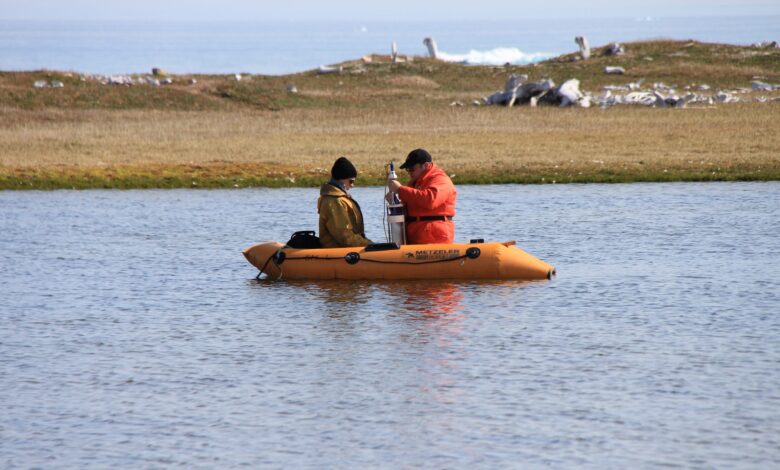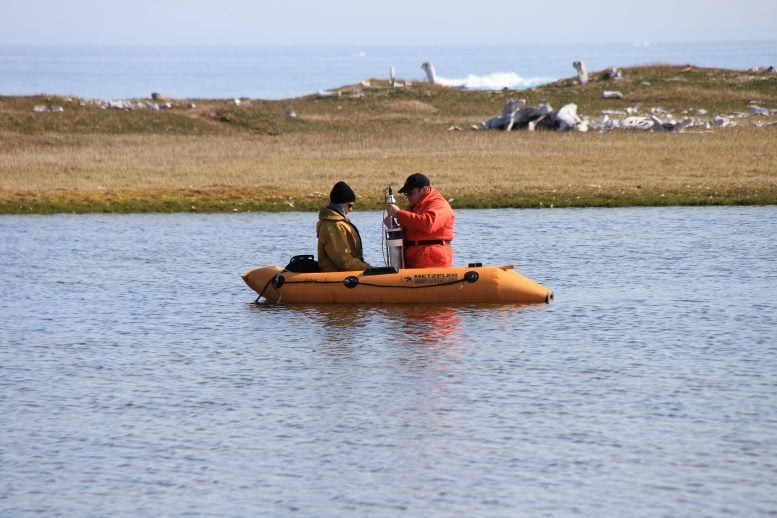New Study Unveils Millennia of Human Histories in Canada’s Arctic


Sampling crew collecting a sediment core at PaJs-13, a Thule-Inuit site on Somerset Island, Nunavut, with the remnants of whalebone houses visible in the background. Credit: Jules Blais, University of Ottawa
Recent findings indicate that Thule-Inuit settlements in Nunavut may date back earlier than previously believed.
A new study sheds light on the ancient cultures of the Paleo-Inuit and Thule-Inuit peoples in Canada’s Arctic, spanning thousands of years. Led by Jules Blais, a biology professor at the University of Ottawa, researchers uncovered evidence of human settlements on Somerset Island, Nunavut, through the analysis of sediment samples.
The Arctic has been home to various cultures, such as the Paleo-Inuit (2500 BCE to 1250 CE) and the Thule-Inuit (1200 to 1500 CE). Although historical evidence is scarce, this recent study provides valuable insight into their presence.
The study discovered evidence of Paleo-Inuit presence on Somerset Island in Nunavut, Canada, where it was lacking. The innovative research methodologies revealed detailed information about past human history without traditional artifacts.
Somerset Island is a large, uninhabited island located in the Canadian Arctic Archipelago in Nunavut, Canada. Known for its remote and rugged terrain, the island spans over 24,000 square kilometers, making it one of the larger islands in the Northern Hemisphere without a permanent population. Its landscape is characterized by tundra, rocky plateaus, and several ice caps, with a cold climate prevailing year-round.
Professor Jules Blais says, “By analyzing pond sediment samples, we were able to construct detailed histories of site occupation. This includes clear evidence of Paleo-Inuit presence and indications that the Thule-Inuit arrived earlier than previously estimated.”
The research used archeological evidence and sedimentary biomarkers to study prehistoric settlements on Somerset Island. Sediment cores from island ponds were analyzed for trace elements and organic compounds. Results showed that the Thule-Inuit population increased from the 13th to 15th centuries. The researchers also showed high levels of metals like lead, copper, zinc, and nickel in twentieth-century sediment, suggesting air pollution during that time.
Advanced Techniques and Implications
Blais says, “We used generalized additive models (GAMs) and radiocarbon dating techniques to identify key time points in the sediment record corresponding to the expected dates of Thule-Inuit arrival and site abandonment. This approach allowed us to detect periods of significant change in sediment proxies, providing a chronological framework for understanding the history of human occupation on the island.”
This research underscores the importance of interdisciplinary approaches in archeology and highlights the significance of sedimentary archives in reconstructing past human activities and environmental conditions.
Blais explains the broader implications of the study. “The use of sedimentary biomarkers and bone samples to uncover prehistoric habits demonstrates the strength of interdisciplinary studies. Our discoveries not only enhance our knowledge of the Thule-Inuit and Paleo-Inuit communities in the Arctic but also demonstrate the potential of new archeological techniques.”
Reference: “Sedimentary biomarkers and bone specimens reveal a history of prehistoric occupation on Somerset Island (Arctic Canada)” by Lauren R. Gallant, Kathryn E. Hargan, Linda E. Kimpe, Neal Michelutti, Christopher Grooms, James M. Savelle, John P. Smol and Jules M. Blais, 1 July 2024, Proceedings of the Royal Society B.
DOI: 10.1098/rspb.2023.2915



